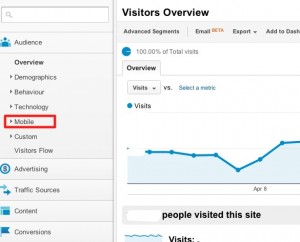Analysing YOUR Mobile Traffic
In the second post from our m-commerce month, we discuss how to assess the quantity of mobile traffic arriving at your ecommerce website and, more to the point, what this traffic is doing when it gets there!
Just this morning, IBM released a report stating that a whopping 13.3% of online sales from Q1 of 2012 originated from mobiles (report covered on DM news). That’s an incredible number and represents a continued rapid growth in the rate at which people browse and buy on their mobile devices.
YOUR Mobile Traffic
Of course, headline grabbing statistics like that don’t offer much breakdown into which particular areas of retail are experience the fastest mobile growth and, more to the point, what proportion of YOUR visits and therefore sales are likely to be originating from mobile devices.
What You’ll Need
- A website with a decent number of visits. It’s difficult to make any assumptions about traffic unless you have enough of it!
- Web traffic Analytics. We use Google Analytics but there are others available. We’ll base this post on Google Analytics.
- Ecommerce tracking where you main aim is a sale or goal tracking where your objective is enquiries/leads.
Analysing Mobile Traffic in Analytics
 Within the Google Analytics dashboard, you’ll see (in the left hand menu) ‘Audience.’ Under this, you’ll find ‘mobile.’ In here is all the usual data you can pull from Analytics but specifically relating to your mobile users.
Within the Google Analytics dashboard, you’ll see (in the left hand menu) ‘Audience.’ Under this, you’ll find ‘mobile.’ In here is all the usual data you can pull from Analytics but specifically relating to your mobile users.
Note: Tablet devices are counted as mobile traffic within Google Analytics too. While tablets are indeed technically mobile, we’ve certainly come across many cases amongst the sites we deal with where tablet traffic is higher converting than even desktop traffic. Smartphone traffic often converts at a lower rate though, where no mobile site exists to cater to these users.
Statistics to Look At
You probably already have way more data about your mobile visitors than you realised!
- First and foremost, look at the number of mobile users you have against non-mobile users. Sometimes it’s even worth a glance back over the past 12 months to give yourself an indication of just how quickly the mobile segment of your traffic has grown.
- Conversion rate from mobile against conversion rate from non-mobile users.
- Average transaction value (for e-commerce sites) amongst mobile and non-mobile users.
Then it’s time to get more device specific in order to truly understand who you’re catering for. Switch to ‘devices’ view in Google Analytics and you will see an entire breakdown of the devices driving traffic to your site and, ultimately, conversions as well.

Actual figures removed
- Separate tablets from mobile phones to understand what quantity of traffic you have from each.
- Again, assess conversion and transaction values from them both.
- Assess conversion rates by device as well and see how your site looks to users on the devices driving the most traffic.
Things to Consider
- Not all users on smartphones are looking to make an online purchase. Account for ‘research online, purchase offline.’ So from this perspective, particularly if you have physical shop locations as well, conversion to sale data online can be misleading. While footfall can’t be easily measured in relation to online activity, consider call tracking as a means of getting an additional layer of data.
- Look at keywords driving users to your site from search. Sometimes these can give you an indication as whether users are looking to make a purchase or are looking for a physical store location. What you present to your mobile users on your site should be tailored to what they are likely to be expecting when they land.
- Although 1 in 3 searches made from mobile now have a local element to them, don’t assume that all users are browsing from mobiles are out and about!
Google Analytics is an incredibly powerful tool that can give you detailed insight into exactly what your users are doing on your website. And while the headline statistics really are incredible and are probably representative of what’s happening in your industry too, there’s no data more relevant to you than exactly what’s happening on your site.

Get 123 pages of expert advice straight to your inbox.
-
Apps (46)
Content Marketing (67)
Digital PR (1)
Integrated Marketing (3)
Multi Screen (12)
News (99)
PPC (2)
Search (120)
Tecmark (70)
Uncategorized (2)

About the Author


